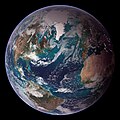پەڕگە:Blue Marble Western Hemisphere.jpg

قەبارەی ئەم پێشبینینە: ٦٠٠ لە ٦٠٠ پیکسەڵ. ڕێزەلووشنەکانی تر: ٢٤٠ لە ٢٤٠ پیکسەڵ | ٤٨٠ لە ٤٨٠ پیکسەڵ | ٧٦٨ لە ٧٦٨ پیکسەڵ | ١٬٠٢٤ لە ١٬٠٢٤ پیکسەڵ | ٢٬٠٤٨ لە ٢٬٠٤٨ پیکسەڵ | ٣٬٧١٨ لە ٣٬٧١٨ پیکسەڵ.
پەڕگەی سەرەکی (٣٬٧١٨ × ٣٬٧١٨ پیکسڵ، قەبارەی پەڕگە: ٢٫٦٥ مێگابایت، جۆری ئێم ئای ئێم ئی: image/jpeg)
مێژووی پەڕگە
کرتە بکە لەسەر یەکێک لە ڕێکەوت/کاتەکان بۆ بینینی پەڕگەکە بەو شێوەی لەو کاتەدا بووە.
| ڕێکەوت/کات | ھێما | ئەندازە | بەکارھێنەر | تێبینی | |
|---|---|---|---|---|---|
| هەنووکە | ١١:٥٩، ٥ی ئازاری ٢٠١٣ |  | ٣٬٧١٨ لە ٣٬٧١٨ (٢٫٦٥ مێگابایت) | Szczureq | User created page with UploadWizard |
بەکارھێنانی پەڕگە
ئەم پەڕەیە ئەم پەڕگەیە بەکار دەھێنێت:
بەکارھێنانی سەرانسەریی پەڕگە
ئەم ویکیانەی دیکەی خوارەوەش ئەم پەڕگە بەکاردێنن:
- بەکارھێنان لە alt.wikipedia.org
- بەکارھێنان لە av.wikipedia.org
- بەکارھێنان لە bn.wikipedia.org
- بەکارھێنان لە ca.wikipedia.org
- بەکارھێنان لە cv.wikipedia.org
- بەکارھێنان لە da.wikipedia.org
- بەکارھێنان لە el.wikipedia.org
- بەکارھێنان لە en.wikipedia.org
- Ecological footprint
- Space art
- User:P3Y229/sandbox
- Wikipedia:Wikipedia Signpost/2018-10-28/Gallery
- Wikipedia:Wikipedia Signpost/Single/2018-10-28
- User:Lngnbchr/TWA/Earth/2
- User:Saoirse mck/TWA/Earth/2
- User:Northamerica1000/Topics
- User:Nikola Tesla edit/TWA/Earth/2
- User:SDL87/TWA/Earth/2
- User:Mpurcell1/TWA/Earth/2
- User:Mpbrooke/TWA/Earth/2
- User:Tlonedyr
- User:JD Gale/TWA/Earth/2
- User:Theincredibleoctupus/TWA/Earth/2
- User:BigChrisKenney/TWA/Earth/2
- بەکارھێنان لە en.wikibooks.org
- بەکارھێنان لە en.wikiquote.org
- بەکارھێنان لە en.wiktionary.org
- بەکارھێنان لە es.wikipedia.org
- بەکارھێنان لە eu.wikipedia.org
- بەکارھێنان لە fa.wikipedia.org
- بەکارھێنان لە fi.wikipedia.org
- بەکارھێنان لە fr.wikipedia.org
- بەکارھێنان لە he.wikipedia.org
- بەکارھێنان لە hu.wikipedia.org
- بەکارھێنان لە hy.wikipedia.org
- بەکارھێنان لە id.wikipedia.org
- بەکارھێنان لە it.wiktionary.org
- بەکارھێنان لە ja.wikipedia.org
- بەکارھێنان لە kk.wikipedia.org
بینینی بەکارھێنانی گشتی زیاتری ئەم پەڕگەیە.


